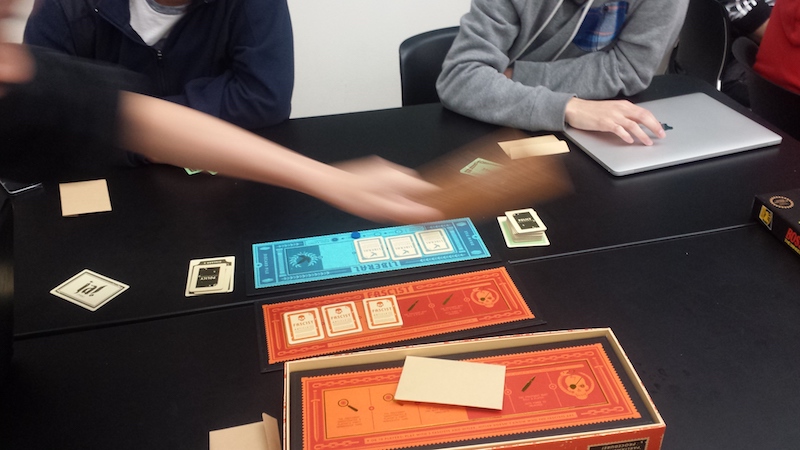

Apologies in advance for the spoiler, it made for a good post title. Here’s a session report of a game of Secret Hitler, a board game based on betrayal and deceit set in 1930s Germany.
This playthrough was done with 5 players: C, R, D, S, and Justin (myself).
Everyone was handed an envelope with their role & party membership cards inside. Each player opened and viewed their private role information before starting. I had a liberal role and party membership card.
To begin the game, every player was instructed to close their eyes. Then, all the secret fascists and the assigned “Hitler” were instructed to open their eyes and acknowledge their party brethren. The fascists and Hitler then closed their eyes, and then all the players were instructed to open then.
Since the President plaque was closest to C, we decided C would start the game off as the President. C chose D as their chancellor.

All the players cast their election votes, and the results were a unanimous “ja!” (yes).
C picked 3 policies from the top of the policy deck, looked them over, and then discarded one. C passed the remaining two to D, who then discarded another and played the final policy, a liberal one. Thus, the liberals had one policy enacted so far.
The President placard made its rotation to the next player at the table, D. D selected me to be the chancellor.
The players made their votes, and I was selected unanimously. David then picked 3 policies from the deck, discarded one, and passed the two over to me. D had passed me two fascist policies. As a liberal, neither policy was in my favor, so my suspicion against D rose as I was forced to enact a fascist policy. Thus, the liberals had one enacted policy and the fascists had one enacted policy.

The President role now passed on to me, and I decided to elect R as chancellor. The votes came in from every player, and the decision was a unanimous yes.
I picked up three policies from the deck, discarded one, and passed my two policy choices to R. R discarded one, and played a liberal policy. I had given R a liberal and a fascist policy, so I knew then I could trust R. At this point, the liberals had two policies enacted and the fascists had one. D questions what policies were given to R, and R told the truth.
The President role jumped to S, who nominated D as chancellor. The votes come in from the players, and the S & D executive pair are voted out! (3 nein (no), 2 ja (yes)). The players’ suspicions on D are rising. The election tracker was incremented, and the President role moved on to R.

R nominated me as chancellor, and the players unanimously vote in support. R picks their policies, hands me the two, and I enact a liberal policy. Now, the liberals have three policies enacted and the fascists have one.
C is now president, and nominates R as the chancellor. One nein vote comes in for the two, which is powerless against the other four ja’s. C discards the one policy from the chosen three, passes the two to R, who enacts a fascist policy. Now the liberals have three policies enacted and fascists have two. D makes raucous discord between the players.
D is now president, and nominates C as the chancellor. Everyone’s suspicion is now on high, and the pair are voted down. The election tracker is incremented to two.

I am now president, and I nominate S. We win the majority vote from the players, and I pass my two policies to S. S enacts the fascist policy. At this point, both the liberals and the fascists have three policies enacted (total of six). With three fascist policies enacted, all current and future presidents are now given the power to examine the top three policies from the policy deck.
S is now president and nominates D. The votes are in, and its four ja’s and one nein. D is elected chancellor, and announces victory: D was Hitler! Since Hitler was elected chancellor after three fascist policies were enacted, the fascists win, and the game ends.